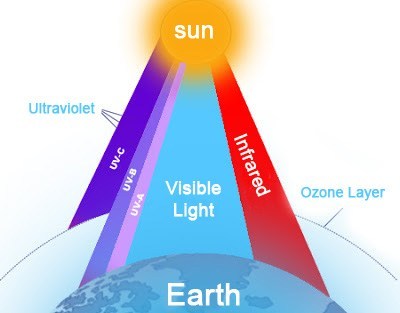| Sometimes we can’t appreciate the blessings we have until they’re no longer there. Sunlight is such a basic thing in our lives: it gives us light, it helps plants grow, and it separates the days from the nights. Even though this may be hard to believe, people with XP can be killed by the UV rays emitted from sunlight! |
|---|

The following information has been gathered from informal sources, including conversations with people with XP and professionals in the field.
Ultraviolet (UV) light is present during all hours of daylight, even when it is dark, cloudy, or raining. UV is invisible and is always present. Sitting in the shade or being outside on a cloudy day can result in levels of UV exposure that are higher than you might imagine. UV light is in sunlight and in indoor fluorescent lights, for some examples. Even incandescent lighting emits very low levels of UV light.
It is very important for people with XP to avoid being exposed to the sun and other sources of UV. People with XP cannot tolerate UV light. UV light damages DNA in cells and people with XP cannot fix the damage. The damage continues to accumulate, often eventually resulting in cancer. Cancer can take many years after UV exposure to develop to the point where it can be detected. Damage caused by many years of exposure cannot be reversed. UV light can damage eyes and can cause blindness of persons with XP. XP is a condition of a cumulative nature; any UV exposure is too much because it adds up.
The longer UVA wavelengths are closer to visible light and represent the greatest proportion of the UV reaching the surface of the earth from the sun. UVA can burn skin quickly. The amount of UVB from the sun is much less than UVA, but the effects of UVB upon DNA cells are greater because they penetrate further into the skin.
The UVA and UVB levels in direct summer sunlight are as much as 5,000 times greater than inside a home with windows protected and lighted by low-wattage incandescent lamps. UV can cause irreparable damage to the DNA of cells, no matter how high the UPF or SPF protection. We suggest the use of light protective (UPF) garments but we caution against assuming that a protective garment can allow unrestricted outdoor activity for people with XP. It is physician recommended that people with XP utilize sunscreen daily, even indoors; use sunscreen under clothes on the full body, arms, face, and neck.
There are many UV sources other than the sun. Any element heated to sufficient temperature produces some radiation in the UV range. Common household incandescent lamps radiate relatively little amounts of UV. Fluorescent lamps generate UV internally to excite the phosphor that produces visible light; they create a greater risk for UV exposure. Quartz-halogen lamps that are not protected with an outer glass bulb or plate radiate potentially harmful UV. Commercial, municipal, and industrial lighting fixtures produce an unknown amount of UV that is dependent on the type of lighting. Some of these light sources use a mercury vapor arc. This type of light without proper filtering and shielding is a source for UVC in amounts not even present in sunlight because they do not reach the surface of the earth due to the protection of the ozone layer.
| Please consult with your dermatologist concerning the suggestions made on this website. What may work for one individual may not work for another one. |
|---|
